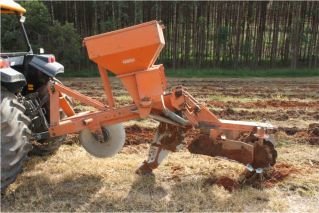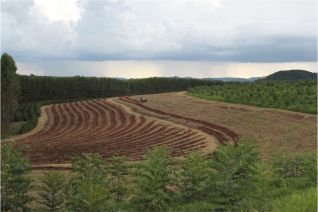SOIL PREPARATION

After choosing the area, soil samples should be collected in the dry season, at 0-20 and 20-40 cm of depth and the mixed samples from each depth should be directed to the following analyses:
| Profundidade | Análise |
| 0-20 cm | Fertility (V%, H+Al and Al), organic matter, sulphur (S), micronutrients (B, Cu and Zn) and texture. |
| 20-40 cm | Fertility (V%, H+Al and Al), texture |
Before planting, proceed to weed control (by weeding, mowing or chemical control).
One should start fighting ants and termites at least 6 months before planting, and continue for at least 18 months thereafter. The constant diligence in this fight is a fundamental practice for crop formation success.

In slope areas, planting should be done in contour lines to prevent soil erosion, which can harm the growth of seedlings. When the slope is steep, the holes should be dug in line and downhill, facilitating thinning and removal of trees in the harvesting.
One should avoid burning the plant material obtained in the mowing.
In areas with soil compaction in the deeper layers of the subsoil, one should employ the subsoiling practice at the minimum depth of 60-70 cm.
The various forms of preparation of an area depend on mechanization feasibility: non-mechanized areas must be dug; mechanized areas should be prepared preferably with a forest subsoiler (flat lifter), and the trencher should be the second alternative. The minimum depth reached in the preparation of the soil should be 40 cm.




Soil praparation using forest subsoiler, Campo Belo, MG.
The holes must be at least 40 cm deep x 40 cm wide x 40 cm long.
The commonly adopted SPACINGS are 3×4 m (12 m2/plant, 833 plants/ha) and 3.5X3.5 m (12.25 m2/plant, 816 plants/ha). We do not recommend spacing smaller than 9 m2 per plant or larger than 13 m2/plant due to thinning intensity in the future and the lack of tests with larger spacing. For planting seedlings produced by seeds, we recommend a spacing of 3 x 2m, with 1667 plants per hectare.
The use of pre-emergent herbicide on the pits or furrows before planting helps in the initial fight against weeds, thereby reducing weeding operations.
